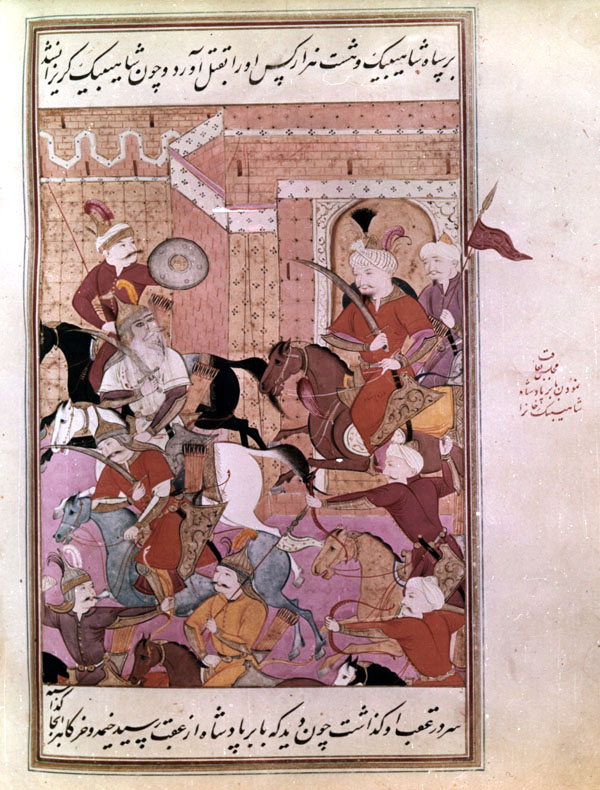)
Bābor Shah Chasing Šāhibeg Khan
Moḥammad Bābor Mirzā, called in this text Bābor Shah (full name Żahir al-Din Moḥammad Bābor Mirzā b. ʿOmar Šeyḵ b. Solṭān Abu Saʿid Mirzā b. Solṭān Moḥammad b. Mirzā Mirānšāh b. Amir Timur Gurkān), the founder of the Mughal dynasty in India, was expelled from his ancestral homeland of Transoxiana by Šāhibeg Khan in 906/1500-01. During the following decade Bābor made several attempts to regain his homeland, often enlisting the support of the qezelbāš, and sometimes being successful in securing limited victories. The text describes in some detail a series of assaults by Šāhibeg Khan against Samarkand, which Bābor and his Čaḡatāy army under the command of Ātāliq Solṭān successfully defend against, killing large numbers of Uzbegs in the process. During one of the prolonged sieges, Bābor requested assistance from the Safavid governor of Bokhara, who responded and was in turn defeated. Subsequently, Šāhibeg Khan came in control of Bokhara. The battle depicted in this painting follows the earlier series of assaults and also takes place at Samarkand, apparently about 1508-09. The text makes little mention of the battle other than saying that Šāhibeg arrived with an army from Bokhara, a pitched battle took place in which 8,000 Uzbegs were killed, and Šāhibeg Khan was forced to flee with all that remained.
In the depiction the pursuit takes place in front of a high walled enclosure, intended to represent the city walls of Samarkand, with arched doorway, turret, and crenelations. Bābor Shah, dressed in vermillion and brandishing a sword, is in the right center on a brown horse that springs forward toward the left in hot pursuit of his adversary. He is accompanied by two mounted warriors shooting arrows, and one meek standard bearer behind him. No contemporary Mughal portraits of Bābor are known, but comparison with a portrait of his grandson Akbar, executed in the time of Jahangir(c.1605, Musée Guimet, Paris, ill. Grube, Islam_1966, color pl.97, and S.C.Welch, MI_1964, pl.29) reveals similar facial characteristics to the Bābor here represented. Šāhibeg, with sword in hand, together with four other Uzbegs, all mounted, occupy the left half of the composition. He looks to the rear at his pursuers, as does a horseman to his right who defends himself with a shield, and another in the lower left who turns to fire an arrow. All five riders are, however, obviously intent on fleeing rather than fighting. Šāhibeg Khan is emphasized by the whiteness of his uniform and horse within a composition that is completely colored, but Bābor Shah is the dominant figure in the composition by virtue of his size, relative visual isolation, and the brightness of his vermillion clothing. The artist may have taken some liberties, however, in portraying Bābor Shah in the midst of the foray, for there is no indication in the text that he personally pursued Šāhibeg Khan, and in actuality seems to have preferred observing a battle from a high vantage point and leaving the direction of the hand to hand combat to his field commander Ātāliq Solṭān. The foreground is executed in light mauve; the backdrop is the citadel wall colored in buff, light salmon, and white. Since the background is executed entirely in pastel colors, the horses and riders stand out by contrast: vermillion, maroon, yellow-orange, and purple clothing; chestnut, light brown, black, white, and gray horses.
Location: Reza Abbasi Museum, Tehran, No.77.1.7, folio 135v
Painting: 21.2 x 15.2 cm. Dimensions after Mahboubian catalog. It is not clear whether the 15.2 cm. includes any of the painting in the margins. Šāhibeg’s face has been very crudely retouched. A marginal inscription in red describes the event depicted. An inscription in red also appears on one of the figures, identify him as bābor An inscription in red also appears on one of the figures, identify him as bābor šāh.
Painting references:
Mahboubian_1972, #923 folio 135v (illustrated).
Text References: See Muntaẓer-Ṣāḥeb_1970, p.260 for this event in the History of Shah Esmāʿil.
Robert Eng
Last Updated: Dec. 15, 2011 | Previous update: Dec. 8, 2010 | Originally published: April 4, 2002
